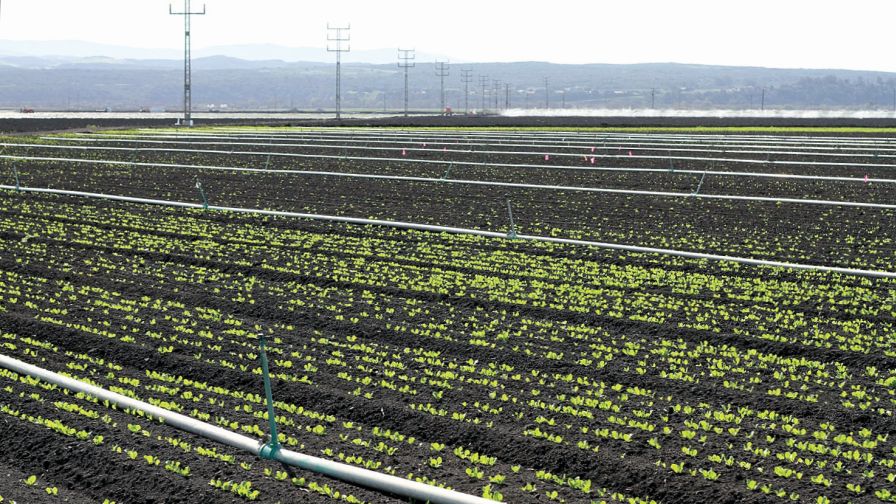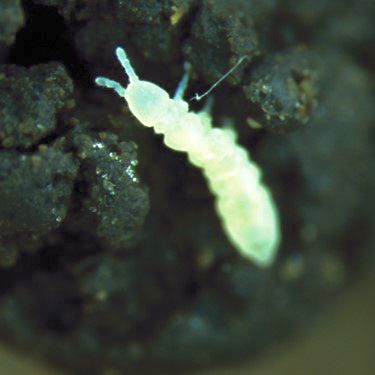Springtail Is an Unexpected Vegetable Pest

In the vegetable fields in California’s northern Salinas Valley, a springtail species (Protaphorura fimata) feeds on the germinating lettuce and broccoli seeds, which lead to poor crop stand. Photo from Shimat Joseph
You normally would not think of springtails — which are found in diverse habitats such as pastures, compost pits, and agriculture lands — as much of a pest. They can be nuisance organisms, but are rarely considered a pest that cause economic damage.
Springtails are generally considered to be beneficial creatures because they help break down decaying plant material by feeding and excreting, thereby participating in the nutrient cycle, which in turn helps improve soil health and structure.
In the vegetable fields in California’s northern Salinas Valley, however, one springtail species (Protaphorura fimata) feeds on the germinating lettuce and broccoli seeds, which leads to poor crop stand.
A few other springtail species have been associated with feeding germinating seeds such as sugar beet, bean and weeds. Also, lucerne flea (Sminthurus viridis) and garden springtail (Bourletiella hortensis) attack the foliage of several plant species, including lucerne and clover.

The springtail species Protaphorura fimata. Photo from Shimat Joseph.
Quick Facts on Protaphorura fimata
Physical characteristics. The springtail that attacks germinating lettuce seeds is less than 2.5 mm long, white, lacks eyes and the jumping organ found in most springtails, the furcular. That means, when disturbed, it does not jump, but instead curls up.
Reproduction. It is unclear if this springtail reproduces after mating. A closely related species has been reported to reproduce without mating.
Origins. Although the same species is present in Europe, there were no detection from agricultural areas. Also, it is not clear whether this springtail was introduced to the U.S. from Europe, or vice versa.
Control Tips
Timing. Germinating seeds (one- or two-day-old lettuce seedlings) are the most vulnerable stage to springtail feeding, resulting in reduction in seedling growth. Thus, it appears that once the roots are established in the soil, lettuce is less susceptible to springtail feeding injury.
Because the germinating phase of the plants is more likely to be injured, springtail monitoring activity should start prior to planting the seeds to determine the presence of springtail in the soil.
The role of temperature. Typically, insects are not very active in cooler temperatures. The springtail, however, is active and feeds on plant tissue at temperatures as low as 41°F, even though seeds germinate slowly in the cooler temperatures.
This suggests that lettuce seedlings might require prolonged protection from springtail, with additional insecticide sprays until the seedlings are established in the cooler temperatures, especially in spring and early summer (January to May).
In the later part of summer, an at-plant application of insecticide is likely to provide adequate springtail control and multiple applications may not be required.
Baits. Beet or potato slice baits attract springtail if placed in the top layer of the soil; thus, these baits could be used for monitoring springtail activity in the soil. If the soil is not moist, the baits may not capture springtails and their activity may go undetected.
Impact of soil moisture. Lettuce fields are heavily irrigated at least once before and up to three weeks after planting the seeds for uniform seed germination and seedling establishment. High moisture content in the soil will favor springtail feeding on the germinating lettuce seeds. In the Salinas Valley, before the lettuce seeds are planted, fields are pre-irrigated to aid land preparation and bed shaping. It has been observed that the springtail density increased from the sub-surface of soil when the field was recently irrigated or after a rain event. This cultural practice which maintains high moisture levels for seed germination on the sub-surface profiles of the soil might be favoring the faster buildup of springtail populations.
Controls. Studies suggest that management of springtails may not be that difficult. Pyrethroid (zeta-cypermethrin, bifenthrin, lambda-cyhalothrin) and neonicotinoid insecticides (dinotefuran, thiamethoxam, and clothianidin), as well as chlorpyrifos, tolfenpyrad, and spinetoram were effective in reducing springtail feeding on germinating lettuce seeds.
As an IPM approach, these insecticides should be used along with a proper monitoring program (i.e., using beet or potato slice baits).
The effectiveness of insecticide use can be enhanced by properly timing the application at planting the seeds.










